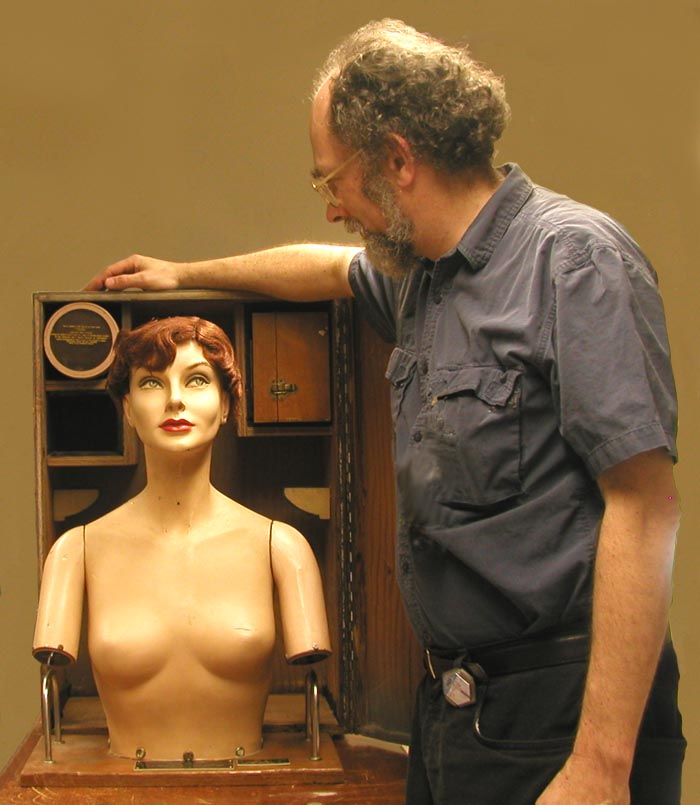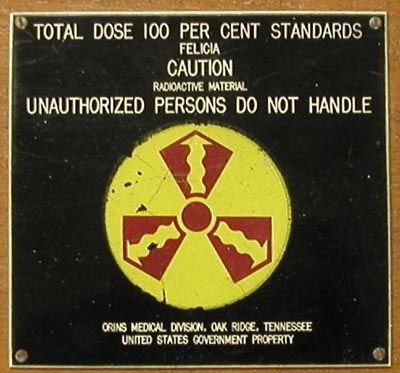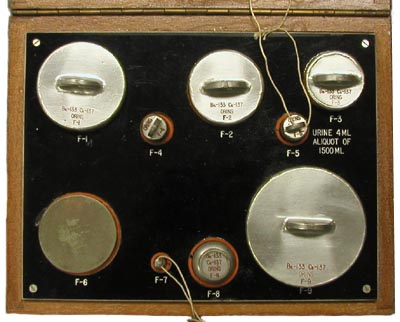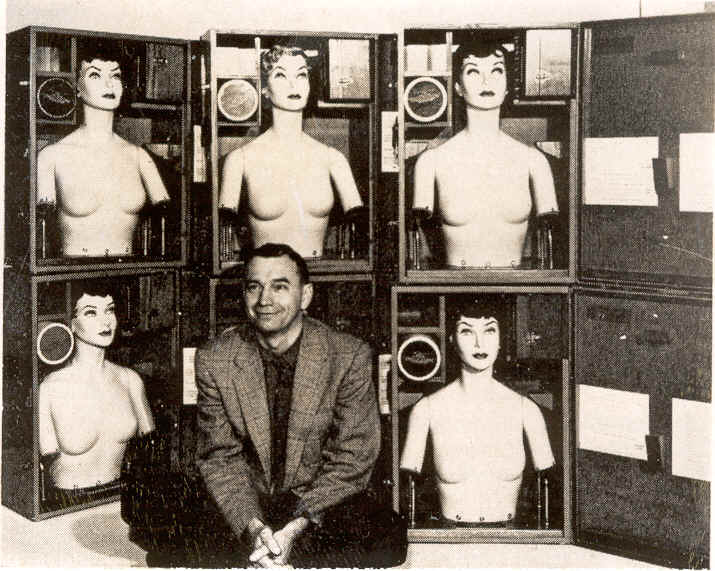ORINS Manikin, Felicia (1955)
This manikin, given the name "Felicia," was produced in 1955 for Marshall Brucer at the Oak Ridge Institute of Nuclear Studies (ORINS), now known as Oak Ridge Associated Universities. For what it’s worth, the ORINS literature typically spelled it as "manikin," but they also employed the spelling "mannequin." The manikin's purpose was to help evaluate the equipment used at medical facilities to measure the uptake of iodine-131 by a patient's thyroid. The condition where too much iodine is absorbed is known as hyperthyroidism, the condition where too little iodine is absorbed is hypothyroidism, and a thyroid that absorbs just the right amount of iodine is a euthyroid.

Towards this end, the manikins were loaded with a sand that contained mock-iodine (a mixture of barium-133 and cesium-137). This sand represented the ingested iodine that would distribute itself more or less uniformly in the body. In addition, various amounts of mock iodine were incorporated into model thyroids that were then positioned in the necks of the manikins. Some manikins modeled hyperthyroidism, some modeled hypothyroidism (e.g., our Felicia), and some modeled a properly functioning thyroid. In addition, three manikins were of a "well-type" construction which meant that the dummy thyroids could be easily changed out. Other than that, the only difference between the various manikins was their hair color—as you can tell, Paul Frame, shown in the photo together with Felicia, is partial to redheads.
A section of Felicia's thigh can be seen in a compartment to the upper left of her head, just below Paul's hand. This was included because some facilities used their patient's thigh to measure "background".
In the compartment to the right of her head is a box that contains a set of standard mock iodine sources. These sources modeled the various types of containers that the iodine might be administered to the patient in, e.g., various sized cups, beakers and capsules.


The photo above left shows the label on the box that contains the sources. The contents of the box are shown above right.

The photo to the right, which appeared in The Trail of the Invisible Light by E.R.N. Grigg, features Marshall Brucer with five of the ORINS' manikins. Grigg's caption was as follows: "Brucer's chorus line. Lulu is now in Baltimore, Felicia in Tokyo, Maria in London and Abigail in Egypt." The reference to Maria is a typo, it should read Moira.
Felicia ultimately made her way here via the University of Tennessee where Dr. Larry Miller had provided accommodations.
In 1955, six manikins had been constructed: Abigail (euthyroid), Bridget (euthyroid), Chloe (euthyroid), Drusilla (hyperthyroid), Euphemia (hyperthyroid), and Felicia (hypothyroid). By 1956, the following manikins had been added: Grenadine (hypothyroid), Hortense (hyperthyroid), Ibis (hyperthyroid), Jezebel (euthyroid), Katrinka (hypothyroid), Lulu (hyperthyroid), Moira (euthyroid), Nabby (hypothyroid), Ophelia (euthyroid), Pandora (well-type), Queenie (well-type), Rhoda (well-type), and Terry Toma (euthyroid). Abigail, Felicia and Lulu were available for one month loans while Bridgit, Drusilla, Jezebell, and Nabby could be loaned out for six months.
References
- Marshall Brucer. Radioiodine Uptake Measurement. Apartado del Acta Radiologica Interamericana. Volume VII, No. 3-4, 1957.
- Marshall Brucer. Thyroid Radioiodine Uptake Measurement: A Standard System for Universal Intercalibration. ORINS 19. June 1959.

Not a harem: How ORAU’s Standard Scanning Manikin contributed to thyroid cancer treatment
Dr. Marshall Brucer recognized the need for a more accurate and realistic way to measure radiation exposure in humans, so he created a manikin (sometimes called a “phantom”) that is about the size of a grown adult female, and it was filled with a material that simulates the density of human tissue.
